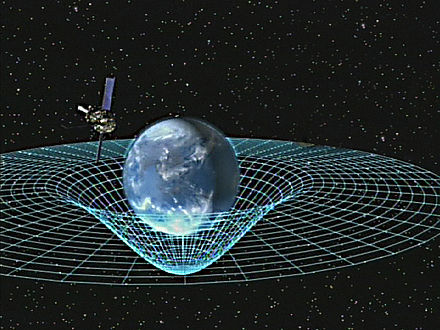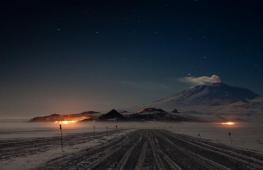See what "Gravity" is in other dictionaries:
Gravitational interaction
The simplest task of celestial mechanics is the gravitational interaction of two point or spherical bodies in empty space. This problem within the framework of classical mechanics is solved analytically in a closed form; the result of its solution is often formulated in the form of Kepler's three laws.
As the number of interacting bodies increases, the problem becomes much more complicated. So, the already famous three-body problem (that is, the motion of three bodies with non-zero masses) cannot be solved analytically in a general form. With a numerical solution, however, the instability of the solutions with respect to the initial conditions sets in rather quickly. When applied to the solar system, this instability makes it impossible to accurately predict the motion of the planets on scales exceeding a hundred million years.
In some special cases, it is possible to find an approximate solution. The most important is the case when the mass of one body is significantly greater than the mass of other bodies (examples: the solar system and the dynamics of Saturn's rings). In this case, as a first approximation, we can assume that light bodies do not interact with each other and move along Keplerian trajectories around a massive body. Interactions between them can be taken into account in the framework of perturbation theory and averaged over time. In this case, non-trivial phenomena may arise, such as resonances, attractors, randomness, etc. A good example of such phenomena is the complex structure of Saturn's rings.
Despite attempts to accurately describe the behavior of a system of a large number of attracted bodies of approximately the same mass, this cannot be done due to the phenomenon of dynamic chaos.
Strong gravitational fields
In strong gravitational fields, as well as when moving in a gravitational field with relativistic velocities, the effects of the general theory of relativity (GR) begin to appear:
- change in the geometry of space-time;
- as a consequence, the deviation of the law of gravity from Newtonian;
- and in extreme cases - the emergence of black holes;
- potential delay associated with the finite propagation velocity of gravitational perturbations;
- as a consequence, the appearance of gravitational waves;
- non-linear effects: gravity tends to interact with itself, so the principle of superposition in strong fields is no longer valid.
Gravitational radiation
One of the important predictions of general relativity is gravitational radiation, the presence of which has not yet been confirmed by direct observations. However, there is strong indirect evidence in favor of its existence, namely: energy losses in close binary systems containing compact gravitating objects (such as neutron stars or black holes), in particular, in the famous PSR B1913 + 16 system (Hulse-Taylor pulsar) - are in good agreement with the GR model, in which this energy is carried away by gravitational radiation.
Gravitational radiation can only be generated by systems with variable quadrupole or higher multipole moments, this fact suggests that the gravitational radiation of most natural sources is directional, which greatly complicates its detection. Gravity power n-pole source is proportional to if the multipole is of electric type, and - if the multipole is of magnetic type , where v is the characteristic velocity of sources in the radiating system, and c is the speed of light. Thus, the dominant moment will be the quadrupole moment of the electric type, and the power of the corresponding radiation is equal to:
where is the tensor of the quadrupole moment of the mass distribution of the radiating system. The constant (1/W) makes it possible to estimate the order of magnitude of the radiation power.
Since 1969 (Weber's experiments ( English)), attempts are being made to directly detect gravitational radiation. In the USA, Europe and Japan, there are currently several operating ground-based detectors (LIGO , VIRGO , TAMA ( English), GEO 600), as well as the LISA (Laser Interferometer Space Antenna) space gravitational detector project). The ground-based detector in Russia is being developed at the Scientific Center for Gravitational-Wave Research "Dulkyn" of the Republic of Tatarstan.
Subtle effects of gravity

Measuring the curvature of space in Earth's orbit (artist's drawing)
In addition to the classical effects of gravitational attraction and time dilation, the general theory of relativity predicts the existence of other manifestations of gravity, which are very weak under terrestrial conditions and therefore their detection and experimental verification are therefore very difficult. Until recently, overcoming these difficulties seemed beyond the capabilities of experimenters.
Among them, in particular, one can name the drag of inertial reference frames (or the Lense-Thirring effect) and the gravitomagnetic field. In 2005, NASA's Gravity Probe B conducted an experiment of unprecedented accuracy to measure these effects near the Earth. The processing of the data obtained was carried out until May 2011 and confirmed the existence and magnitude of the effects of geodesic precession and drag of inertial frames of reference, although with an accuracy slightly less than originally assumed.
After intensive work on the analysis and extraction of measurement noise, the final results of the mission were announced at a press conference on NASA-TV on May 4, 2011 and published in Physical Review Letters. The measured value of the geodesic precession was −6601.8±18.3 milliseconds arcs per year, and the drag effect - −37.2±7.2 milliseconds arcs per year (compare with the theoretical values of −6606.1 mas/year and −39.2 mas/year).
Classical theories of gravity
See also: Theories of gravityDue to the fact that the quantum effects of gravity are extremely small even under the most extreme experimental and observational conditions, there are still no reliable observations of them. Theoretical estimates show that in the overwhelming majority of cases one can confine oneself to the classical description of the gravitational interaction.
There is a modern canonical classical theory of gravity - the general theory of relativity, and many hypotheses and theories of varying degrees of development that refine it, competing with each other. All of these theories give very similar predictions within the approximation in which experimental tests are currently being carried out. The following are some of the major, most well developed or known theories of gravity.
General theory of relativity
In the standard approach of the general theory of relativity (GR), gravity is initially considered not as a force interaction, but as a manifestation of the curvature of space-time. Thus, in general relativity, gravity is interpreted as a geometric effect, and space-time is considered in the framework of non-Euclidean Riemannian (more precisely, pseudo-Riemannian) geometry. The gravitational field (a generalization of the Newtonian gravitational potential), sometimes also called the gravitational field, in general relativity is identified with the tensor metric field - the metric of four-dimensional space-time, and the gravitational field strength - with the affine connection of space-time, determined by the metric.
The standard task of general relativity is to determine the components of the metric tensor, which together determine the geometric properties of space-time, according to the known distribution of energy-momentum sources in the four-dimensional coordinate system under consideration. In turn, knowledge of the metric makes it possible to calculate the motion of test particles, which is equivalent to knowing the properties of the gravitational field in a given system. In connection with the tensor nature of the GR equations, as well as with the standard fundamental justification for its formulation, it is believed that gravity also has a tensor character. One of the consequences is that the gravitational radiation must be at least of the quadrupole order.
It is known that there are difficulties in general relativity due to the non-invariance of the energy of the gravitational field, since this energy is not described by a tensor and can be theoretically determined in different ways. In classical general relativity, the problem of describing the spin-orbit interaction also arises (since the spin of an extended object also does not have a unique definition). It is believed that there are certain problems with the uniqueness of the results and the justification of consistency (the problem of gravitational singularities).
However, GR is experimentally confirmed until very recently (2012). In addition, many alternative to Einsteinian, but standard for modern physics, approaches to the formulation of the theory of gravity lead to a result that coincides with general relativity in the low-energy approximation, which is the only one available now for experimental verification.
Einstein-Cartan theory
The Einstein-Cartan (EC) theory was developed as an extension of GR, internally including a description of the impact on space-time, in addition to energy-momentum, also the spin of objects. In the EC theory, affine torsion is introduced, and instead of pseudo-Riemannian geometry for space-time, Riemann-Cartan geometry is used. As a result, they pass from the metric theory to the affine theory of space-time. The resulting equations for describing space-time fall into two classes. One of them is similar to general relativity, with the difference that the curvature tensor includes components with affine torsion. The second class of equations defines the relationship between the torsion tensor and the spin tensor of matter and radiation. The resulting corrections to general relativity under the conditions of the modern universe are so small that even hypothetical ways to measure them are not yet visible.


